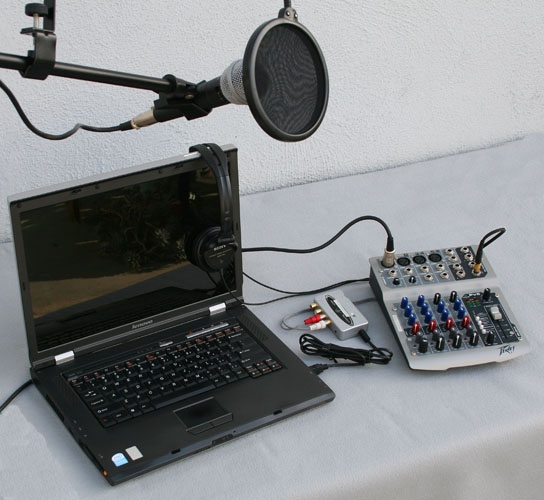Audiobook Mastering
This is a suite of Audacity tools and process to help you produce an audiobook reading that reaches ACX Technical Compliance.
Install the ACX Check plugin
Download and install the ACX Check plugin which will help you check the levels of your recording.
If you are using a version of Audacity previous to 2.4.1 you will also need to download and install rms-normalize
Setup
Start this process with an unedited recording. No processing, adjustments or fixes.
Export a WAV (Microsoft) 16-bit sound file of your raw reading and save it in a safe place—ideally not on the machine. You should never be stuck reading a chapter again because of an accident. Saving an Audacity Project is not recommended for this.
Process
Automatic
To automate the audiobook mastering process, first download the macro:
Then, in Audacity, go to Tools -> Macro Manager and press the Import... button and browse to the file. Import it and then close the Macro Manager.
You now can apply the Audiobook Mastering Macro via Tools -> Apply Macro -> Audiobook-Mastering-Macro similarly to how you would apply any individual effect.
Manual
These instructions are in short-form: Menu > Tool : Options > Apply
Select the whole reading or chapter by clicking the Select button at the bottom of the Track Control Panel.
Effect > EQ and Filters > Filter Curve EQ... : Presets & settings > Factory Presets > Low roll-off for speech > Apply.
Effect > Volume and Compression > Loudness Normalization... : Normalize RMS to -20dB > Apply.
Effect > Volume and Compression > Limiter... : Soft Limit, 0.00, 0.00, -3.50dB, 10.00, No > Apply.
Analyze > ACX Check.
The first two readings, Peak (no louder than -3dB) and RMS (between -18dB and -23dB) should be nearly perfect. If the noise is quieter than about -65dB (-60dB limit), and the show sounds reasonable, you may be done.
The tool settings are sticky and you don't have to keep typing them in. If you do no other editing, mastering a chapter comes down to:
Select the audio track or clip.
Effect > EQ and Filters > Filter Curve... > Apply.
Effect > Volume and Compression > Loudness Normalization... > Apply.
Effect > Volume and Compression > Limiter... > Apply.
If you fail noise, then the process can be a great deal more interesting. See Noise Compliance below.
Notes and Comments
ACX has their own help pages, tutorials and videos: https://help.acx.com/
This mastering suite addresses technical considerations. Nothing here will address theatrical errors such as harsh sibilance, gritty voice or wet mouth noises. There is no acting filter. You have to know how to read aloud.
The quality of the original recording is very important. It's easy to record mistakes that can't be fixed later. Record to a reasonable volume (occasional peaks at -6dB) in a quiet room with no echoes.
When you get done with a chapter, File > Export the work as WAV (Microsoft, 16-bit) and save the sound file with a unique name somewhere safe. That's your emergency backup so you don't have to read it again if you damage the work or lose your edit.
Only then start editing, processing, filtering and correcting. Keep testing the work with the ACX Check plugin as you go. Select the work and Analyze > ACX Check.
ACX Technical requirements for each submitted audio file
Peaks no louder than -3dB.
RMS (performance loudness) between -18dB and -23dB.
Noise no louder than -60dB.
Those are the three values displayed in the ACX Check panel

Human Quality Control at ACX (the theatrical test after you pass ACX-Check technical test) does not like heavy processing. You should be as gentle as you can with as few corrections as possible. Don't even think of submitting readings that sound like a bad cellphone, speaking into a wineglass or reading in a bathroom.
Noise Compliance
We assume you've already been through Audiobook Mastering and failed ACX Technical Compliance because of noise (louder than -60dB) or your performance has odd background sounds you don't like. Noise is common in a home studio.
Microphone Hiss
This is a gentle spring rain in the trees sound behind your voice. Microphone systems make noises like this naturally and it's your job to make your voice loud enough so nobody notices the noise, but not so loud your voice distorts.
If the hiss isn't too bad, try a gentle correction such as Noise Reduction of the Beast (6, 6, 6) or Edit > Undo and try 9, 6, 6. You can hear the hiss getting quieter and recede into the background as you increase the first number. Apply Nose Reduction and then try ACX Check again. If you need reduction as high as 12, 6, 6, your voice may get wine-glassy or honky and the show may not pass ACX inspection.
The solution may be to change your announcing style or even the microphone. You should be about a shaka away from the microphone...

... or as close as a fist (louder and more intimate) but you may need a pop and blast filter.

Machine Noise
Computer fan, air conditioning, refrigerators or other machines.
If possible turn off fans or machines while you're presenting. And yes, we understand the contradiction of needing to watch the Audacity screen, remove the noisy computer from your room and keep the computer one USB cable away from your USB microphone all at the same time.
People have done it by extending the keyboard, mouse and monitor outside their studio, but you are warned against extending a USB cable, particularly with audio (or video) production.
Do not block computer vent holes.
If machine noises are constant and not seriously loud, they may respond to Effect > Noise Removal and Repair > Noise Reduction...
Try a gentle correction such as Noise Reduction of the Beast (6, 6, 6) or UNDO and try 9, 6, 6. You can hear the hiss getting quieter and recede into the background as you increase the first number: Nose Reduction. Try ACX-Check. If you need reduction as high as 12, 6, 6, your voice may get wine-glassy or honky and the show may not pass ACX inspection.
Mosquito Whine
Some computers and USB microphones hate each other and produce mosquito whine sound.
Whine doesn't respond well to Effect > Noise Removal and Repair > Noise Reduction.
Get and install Mosquito-Killer4.
Effect > n / a > Mosquito-Killer4: ...Mosquitoes to kill?: 8 > Apply.
We expect the tool to make common USB whine vanish, but there are some versions of whine that don't perfectly respond. Listen carefully and if Mosquito_Killer4 fails or doesn't work enough, Edit > Undo and post a help message on the Audacity Forum or the Audacity Server on Discord with a sample of the work.
Follow the instructions provided to post an audio sample
I don't know of any easy, foolproof way to permanently fix a USB microphone once you have the whine sound. The most likely fix is change the computer. ACX did it by not using a USB microphone. They used a very high quality analog microphone plugged into a stable USB interface.
Permanent or Impossible Noise
There are no tools to remove noises that constantly change. If jets overhead, traffic noises, dogs barking and the TV next door are included in your show, they are now your permanent performance partners. Read the work again in a quieter room. Gating doesn't help.
Combo Pack
Nobody said you can't have more than one noise. The ACX Audiobook noise test can be rough to pass with a home recording system. If you just can't get there with the above tools, or you can't get your voice to sound right, post to the Audacity Forum or the Audacity Server on Discord with a sound sample and send a clean, raw clip. Mention the three-digit Audacity number.
Follow the instructions provided to post an audio sample
Last updated
Was this helpful?